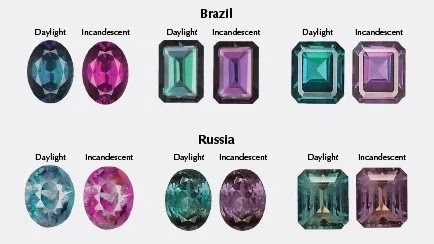The Largest Alexandrite Producers in the World
Alexandrite is a gemstone that belongs to the chrysoberyl mineral group. It was first discovered in the Ural Mountains of Russia in the 1830s, and was named after the Russian tsar Alexander II. Alexandrite is unique in that it displays a color change effect, appearing green in natural light and red or purplish-red in artificial light.
The color change is due to the presence of chromium and other trace elements in the crystal structure, which cause the absorption of certain wavelengths of light. The more vivid and distinct the color change, the more valuable the stone is considered to be.
Alexandrite is a relatively hard and durable gemstone, with a Mohs hardness of 8.5. It is considered to be a rare and highly prized gemstone, and is often used in high-end jewelry pieces. While natural alexandrite is quite rare and expensive, there are also lab-created versions of the stone that are more affordable and widely available.
Presently, small quantities of Alexandrite are mined in Brazil, Sri Lanka, India, Myanmar, Tanzania and Zimbabwe. Most of the current production is alluvial where the alexandrite constitutes a small percentage of the overall chrysoberyl production. India is the only country that produces a significant quantity of alexandrite today and even there, production is limited.
In Brazil, alexandrite has been found in the states of Espento Santos, Bahia Minas Gerais. Minas Gerais was formed mainly by colonists who searched for veins of gold and gems and later diamonds. The name literally means "general mines", a shortening from Minas dos Matos Gerais, or mines of the general woods. Minas Gerais is so rich in gemstones that they have been found in excavations for building foundations, in drainage ditches, in water wells and in road cuts. Mining techniques in Brazil are mostly primitive but effective with relatively few mines using modern techniques. Brazil still has enormous gem potential. Little research has been done on country´s gem reserves and large deposits have almost always been discovered by accident. The chrysoberyl from Brazil exhibits a variety of colors including grey-white, pale-yellow, citron-yellow, olive-green, grass-green, and pale-green. Some of the colorless stones approach diamond in transparency and brilliancy. Most of chrysoberyl is found as pebbles in auriferous muds or clays derived from the weathering of nearby granitic and gneissic rocks in the Piauhy and Calhao rivers.
In 1987 a major strike of alexandrite was made in the Brazilian state of Minas Gerais at Hematita. As soon as news of the find leaked out, three thousand garimpeiros (independent prospectors) descended on the small valley, five hundred feet wide by six hundred fifty feet long, and began to dig.




